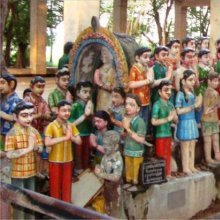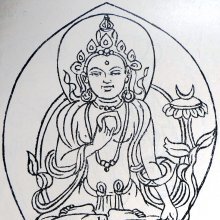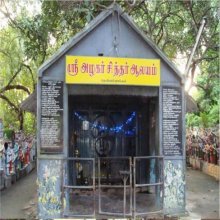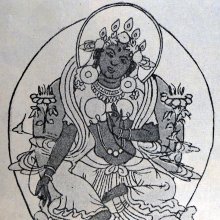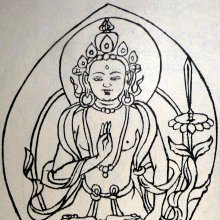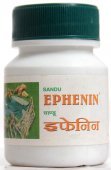Thu, Thū: 5 definitions
Introduction:
Thu means something in Marathi, Jainism, Prakrit, Hindi. If you want to know the exact meaning, history, etymology or English translation of this term then check out the descriptions on this page. Add your comment or reference to a book if you want to contribute to this summary article.
Images (photo gallery)
(+75 more images available)
Languages of India and abroad
Marathi-English dictionary
Source: DDSA: The Molesworth Marathi and English Dictionarythū (थू).—ad Imit. of the sound in spitting. Hence an interjection of contempt or reviling, fie! hoot! out!
Source: DDSA: The Aryabhusan school dictionary, Marathi-Englishthū (थू).—ad Imit. of the sound in spitting. An interj. of contempt or reviling, fie, hoot, out.
--- OR ---
ṭhu (ठु).—or -
Marathi is an Indo-European language having over 70 million native speakers people in (predominantly) Maharashtra India. Marathi, like many other Indo-Aryan languages, evolved from early forms of Prakrit, which itself is a subset of Sanskrit, one of the most ancient languages of the world.
Hindi dictionary
Source: DDSA: A practical Hindi-English dictionaryThū (थू):—(nm) the sound made in spitting; (ind) an expression of indigation and contempt; shame ! fie ! pish !; -[thū karanā] see [thuḍī-thuḍī karanā; -thū honā] see -[thuḍī-thuḍī honā].
...
Prakrit-English dictionary
Source: DDSA: Paia-sadda-mahannavo; a comprehensive Prakrit Hindi dictionaryṬhu (ठु) in the Prakrit language is related to the Sanskrit word: Draṣṭṛ.
Ṭhu has the following synonyms: Daṭ.
Prakrit is an ancient language closely associated with both Pali and Sanskrit. Jain literature is often composed in this language or sub-dialects, such as the Agamas and their commentaries which are written in Ardhamagadhi and Maharashtri Prakrit. The earliest extant texts can be dated to as early as the 4th century BCE although core portions might be older.
Kannada-English dictionary
Source: Alar: Kannada-English corpusṬhū (ಠೂ):—[noun] (children’s term) abstaining from being friends (as from anger).
--- OR ---
Thū (ಥೂ):—
1) [noun] the sound made while spitting.
2) [noun] a term used to express one’s disgust, disappointment, contempt, etc.
Kannada is a Dravidian language (as opposed to the Indo-European language family) mainly spoken in the southwestern region of India.
See also (Relevant definitions)
Starts with (+1540): Thu-reen, Thu-rian, Thu-rian-khaek, Thua, Thua, Thua din, Thua hon, Thua khaao, Thua khaek, Thua khieo, Thua lisong, Thua lisongna, Thua pae, Thua phum, Thua rachamat, Thua rai, Thua sealulium, Thua thong, Thua-daeng, Thua-khalapo.
Ends with (+1681): A-karaipatuttu, A-potaikkappotu, Aane thanthu, Abhithu, Abhitthu, Acanantiruttu, Acaratu, Acattu, Accuruttu, Accuttiruttu, Acittu, Aesagale mutthu, Aggasavaka Vatthu, Aggibatthu, Aghatavatthu, Ai-tinaiaimpatu, Ai-tinaielupatu, Aikkiyaviruntu, Aimthu, Ainteluttu.
Full-text (+8972): Evam, Dat, Prithu, Itthambhuta, Iti, Kritavepathu, Ittham, Thu-reen, Thukanem, Gamvathi, Thunati, Abhitthunati, Thavati, Bue thu, Han-thu, Thu-rian, Nitthunati, Ma thu-i, Thu-rian-khaek, Drashtri.
Relevant text
Search found 499 books and stories containing Thu, Thū, Ṭhu, Ṭhū; (plurals include: Thus, Thūs, Ṭhus, Ṭhūs). You can also click to the full overview containing English textual excerpts. Below are direct links for the most relevant articles:
Mandukya Upanishad (Gaudapa Karika and Shankara Bhashya) (by Swami Nikhilananda)
Mandukya Karika, verse 4.4 < [Chapter IV - Alatashanti Prakarana (Quenching the firebrand)]
Mandukya Karika, verse 4.78 < [Chapter IV - Alatashanti Prakarana (Quenching the firebrand)]
Mandukya Karika, verse 4.54 < [Chapter IV - Alatashanti Prakarana (Quenching the firebrand)]
The history of Andhra country (1000 AD - 1500 AD) (by Yashoda Devi)
Part 23 - Bhimadeva Kesavadeva (A.D. 1231-1235) < [Chapter XX - The Telugu Cholas (Chodas)]
Introduction (Saluva dynasty) < [Chapter XVIII - The Saluvas]
Part 26 - Dayabhima and Nallasiddha I (A.D. 1187-1214) < [Chapter XX - The Telugu Cholas (Chodas)]
History of Indian Medicine (and Ayurveda) (by Shree Gulabkunverba Ayurvedic Society)
Chapter 9 - Thu use of Ornaments < [Part 4 - Some Aspects of Life in Caraka’s Times]
Chapter 6 - Method of Nomenclature < [Part 6 - The Science of the Triumvirate (Tridosha) Pathogenesis]
Chapter 13 - Conclusion < [Part 6 - The Science of the Triumvirate (Tridosha) Pathogenesis]
Socially Engaged Buddhism (with reference to Australian society) (by Phuong Thi Thu Ngo)
B (1). Political Ideal in the Time of Buddha < [Chapter 5]
Socially Engaged Buddhism during the Time of the Buddha < [Chapter 1]
Preceptors of Advaita (by T. M. P. Mahadevan)
(i) Ātreya Brahmanandi and Draidāchārya < [50. Some Pre-Śaṅkara Advaitins]
Bodhisattvacharyavatara (by Andreas Kretschmar)
Text Section 125 < [Khenpo Chöga’s Oral Explanations]
Bibliography Of Sūtras, Tantras And śāstras
Text Section 151-153 < [Khenpo Chöga’s Oral Explanations]
Related products
(+51 more products available)
